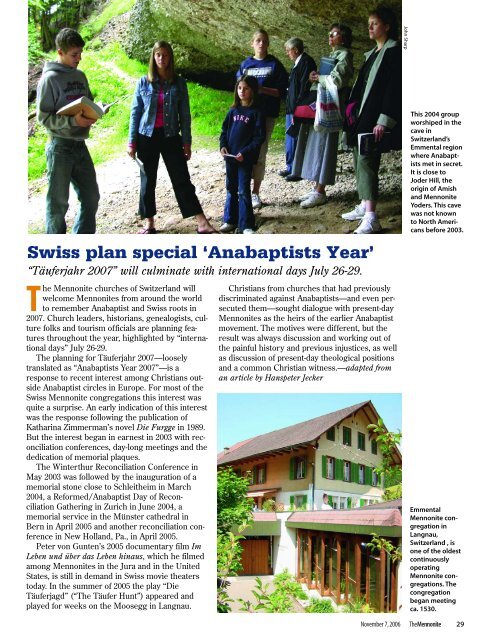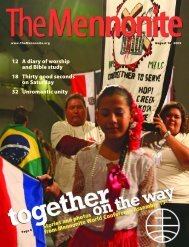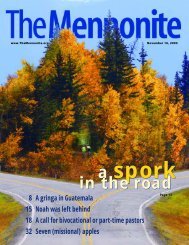11:7,6 - The Mennonite
11:7,6 - The Mennonite
11:7,6 - The Mennonite
Create successful ePaper yourself
Turn your PDF publications into a flip-book with our unique Google optimized e-Paper software.
Swiss plan special ‘Anabaptists Year’<br />
“Täuferjahr 2007” will culminate with international days July 26-29.<br />
<strong>The</strong> <strong>Mennonite</strong> churches of Switzerland will<br />
welcome <strong>Mennonite</strong>s from around the world<br />
to remember Anabaptist and Swiss roots in<br />
2007. Church leaders, historians, genealogists, culture<br />
folks and tourism officials are planning features<br />
throughout the year, highlighted by “international<br />
days” July 26-29.<br />
<strong>The</strong> planning for Täuferjahr 2007—loosely<br />
translated as “Anabaptists Year 2007”—is a<br />
response to recent interest among Christians outside<br />
Anabaptist circles in Europe. For most of the<br />
Swiss <strong>Mennonite</strong> congregations this interest was<br />
quite a surprise. An early indication of this interest<br />
was the response following the publication of<br />
Katharina Zimmerman’s novel Die Furgge in 1989.<br />
But the interest began in earnest in 2003 with reconciliation<br />
conferences, day-long meetings and the<br />
dedication of memorial plaques.<br />
<strong>The</strong> Winterthur Reconciliation Conference in<br />
May 2003 was followed by the inauguration of a<br />
memorial stone close to Schleitheim in March<br />
2004, a Reformed/Anabaptist Day of Reconciliation<br />
Gathering in Zurich in June 2004, a<br />
memorial service in the Münster cathedral in<br />
Bern in April 2005 and another reconciliation conference<br />
in New Holland, Pa., in April 2005.<br />
Peter von Gunten’s 2005 documentary film Im<br />
Leben und über das Leben hinaus, which he filmed<br />
among <strong>Mennonite</strong>s in the Jura and in the United<br />
States, is still in demand in Swiss movie theaters<br />
today. In the summer of 2005 the play “Die<br />
Täuferjagd” (“<strong>The</strong> Täufer Hunt”) appeared and<br />
played for weeks on the Moosegg in Langnau.<br />
Christians from churches that had previously<br />
discriminated against Anabaptists—and even persecuted<br />
them—sought dialogue with present-day<br />
<strong>Mennonite</strong>s as the heirs of the earlier Anabaptist<br />
movement. <strong>The</strong> motives were different, but the<br />
result was always discussion and working out of<br />
the painful history and previous injustices, as well<br />
as discussion of present-day theological positions<br />
and a common Christian witness.—adapted from<br />
an article by Hanspeter Jecker<br />
John Sharp<br />
This 2004 group<br />
worshiped in the<br />
cave in<br />
Switzerland’s<br />
Emmental region<br />
where Anabaptists<br />
met in secret.<br />
It is close to<br />
Joder Hill, the<br />
origin of Amish<br />
and <strong>Mennonite</strong><br />
Yoders. This cave<br />
was not known<br />
to North Americans<br />
before 2003.<br />
Emmental<br />
<strong>Mennonite</strong> congregation<br />
in<br />
Langnau,<br />
Switzerland , is<br />
one of the oldest<br />
continuously<br />
operating<br />
<strong>Mennonite</strong> congregations.<br />
<strong>The</strong><br />
congregation<br />
began meeting<br />
ca. 1530.<br />
November 7, 2006 <strong>The</strong><strong>Mennonite</strong> 29







